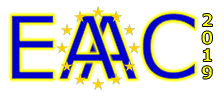Speaker
Description
Plasma based electron acceleration is widely considered as a promising concept for compact electron accelerators with broad range of applications. These accelerators can be driven by either ultra-intense laser beams (LWFA) or high-current particle beams (PWFA).
Here, we report on a novel approach to combine both schemes in a compact experimental setup. In our “LWFA + PWFA” hybrid accelerator, the electron beam generated by a LWFA stage drives a subsequent PWFA stage where a witness beam is trapped and accelerated. This aims to combine the unique features of both plasma acceleration techniques: the LWFA stage provides with a compact source of high-current electron beams required as PWFA drivers, while the PWFA stage acts as an energy and brightness transformer.
In this work, we show the first experimental evidence of accelerating a distinct witness bunch in a LWFA-driven PWFA (LPWFA) within only about one millimeter acceleration distance. In the self-ionizing case, we observe witness energies of around 50 MeV. By utilizing a counter-propagating pre-ionization laser, the interaction with the plasma becomes stronger, increasing the final energies to around 130 MeV. Thus, yielding a field gradient of 70 GeV/m which is comparable to what has been shown at large scale PWFA facilities.

